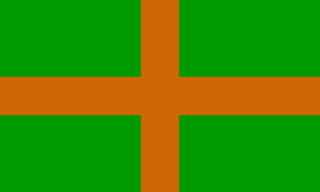
The International Four Day Marches Nijmegen is the largest multiple day marching event in the world. It is organised every year in Nijmegen, Netherlands in mid-July as a means of promoting sport and exercise. Participants walk 30, 40 or 50 kilometres daily depending on their age and gender and, on completion, receive a royally approved medal (Vierdaagsekruis). The participants are mostly civilians, but there are also a few thousand military participants.

The Order of Orange-Nassau is a civil and military Dutch order of chivalry founded on 4 April 1892 by the Queen regent Emma, acting on behalf of her under-age daughter Queen Wilhelmina.
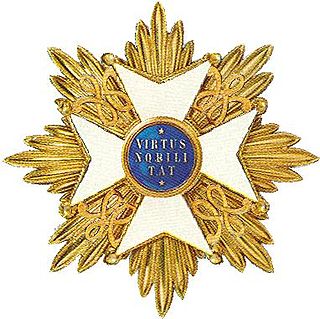
In the Dutch honours system, most orders are the responsibility of ministers of the Netherlands Government. The house orders, however, are awarded at the discretion of the Dutch monarch alone.

The Royal Order of the Lion was established by King Leopold II of Belgium on 9 April 1891, in his capacity as ruler of the Congo Free State, and was awarded for services to the Congo and its ruler that did not deserve the award of the Order of the African Star, and were not necessarily performed from within Belgian Congo.
Jan Jozef Lambert van Hoof was a member of the Dutch resistance in World War II, who cooperated with Allied Forces during Operation Market Garden. He is credited with disabling explosives placed by the Germans to destroy a vital bridge to delay allied liberation, and was later executed in action. Before and during the war, Van Hoof was a Rover Scout, and the Scouting medal the Nationale Padvindersraad was named in his honour.

The Netherlands competed at the 2008 Summer Olympics in Beijing, People's Republic of China. This was announced in an official statement on the NOC*NSF website. In the statement they named the Olympic Games and the Paralympic Games as a highlight in sports to which a lot of sportspeople, coaches and the Dutch sports fans would look forward. The Netherlands aimed for a top 10 nations ranking in the Olympics as well as a top 25 ranking in the Paralympics; they ended up ranking 12th at the Games.
The Honorary Medal for Merits toward Museum Collections, also known as the Museum Medal, is one of the oldest civil decorations of the Netherlands. It was created by royal decree on 26 June 1817 by King William I of the Netherlands. The decree describes the following: "Erepenning voor blijken van belangstelling in 's Rijksverzamelingen door schenking betoond". The medal is awarded in gold, silver or bronze as a token of appreciation to those who "aan hen, die enig boek- of kunstwerk, dat de vrucht van hun arbeid was, de Koning deden toekomen".
The avondvierdaagse is an annual Dutch and Surinamese walking event where the participants walk for four days.

The Ruit Bonjol commemorates the conquest of the fortress Bonjol in the former Dutch East Indies in 1837 after the prolonged Padri War against Tuanku Imam Bonjol and his followers.
The Star for Loyalty and Merit was a civilian award established on 1 January 1894 by Governor-General Carel Herman Aart van der Wijck of the Dutch East Indies. The star replaced the old Medal for Civil Merit, which had limited prestige and status according to the Netherlands government. The star was awarded in gold to "significant and meritorious" natives, and in silver to village chiefs and leaders of the "Eastern foreigner" communities. Dutch (Europeans) were not eligible to receive the star.

The Aceh Medal was founded by King William III of the Netherlands on May 12, 1874, in a royal decree. The medal was presented to troops participating in the First Aceh Expedition and the Second Aceh Expedition.

Vice admiral Matthieu Borsboom is a retired Royal Netherlands Navy officer who is a former Commander of the Royal Netherlands Navy and Admiral Benelux, and has served with the International Security Assistance Force in Afghanistan.
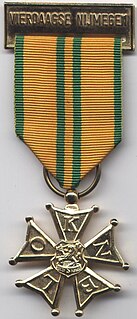
The Cross for the Four Day Marches is a Dutch decoration awarded for successful participation in the International Four Days Marches Nijmegen held annually at Nijmegen, The Netherlands. The full title of the decoration is Kruis Voor Betoonde Marsvaardigheid. It is more commonly referred to as the Vierdaagse Cross or Vierdaagsekruis.
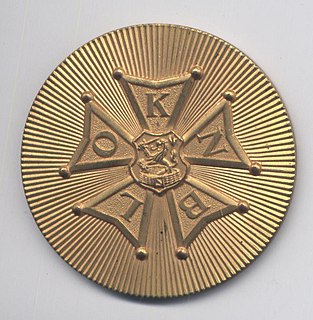
The Group Medal of the Four Day Marches is a non wearable bronze presentation medal awarded to each registered group who successfully completes all four days of the International Four Days Marches Nijmegen held annually at Nijmegen, Netherlands.

The Resistance Memorial Cross or Resistance Commemorative Cross is a medal awarded in the Netherlands to members of the Dutch resistance during the Second World War.
The Expedition Cross officially known as the Cross for Important Military Operations was a military decoration of Kingdom of the Netherlands. Created by royal decree on 19 February 1869, by King William III, the cross was awarded for participation in major military operations between 1846 and 1942.
Pieter verLoren van Themaat was a Dutch law professor, civil service worker, and Advocate-General of the European Court of Justice.

Ailke Westerhof was a Dutch nurse who served in the Red Cross during the Balkan Wars and World War I.

As of 2018, Wolters Kluwer ranks as the Dutch biggest publisher of books in terms of revenue. Other notable Dutch houses include Brill and Elsevier.
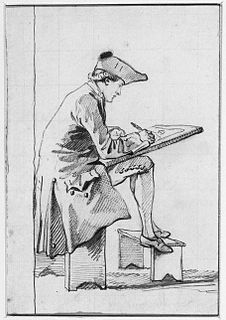
The Stadstekenacademie was an 18th-century art academy in Amsterdam. It was the precursor of the Koninklijke Academie and the Rijksakademie van beeldende kunsten. Other Dutch towns such as Haarlem also had a drawing academy.















